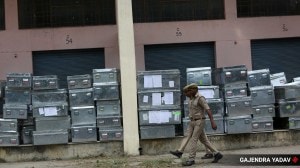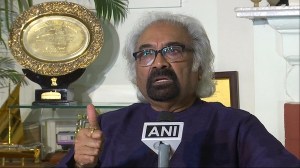- India
- International
Finding Sukumara Kurup: Recreating a 37-year-old murder case that has become folklore in Kerala
What’s the quickest way to get a lot of money? The answer presented itself to Sukumara Kurup through a story he accidentally read in an English detective magazine one night. To anyone else, it may have sounded outlandish, but for a man who held a daredevil attitude to life, it seemed just right. Former Kerala Police officers recount one of the most notorious cases of their career
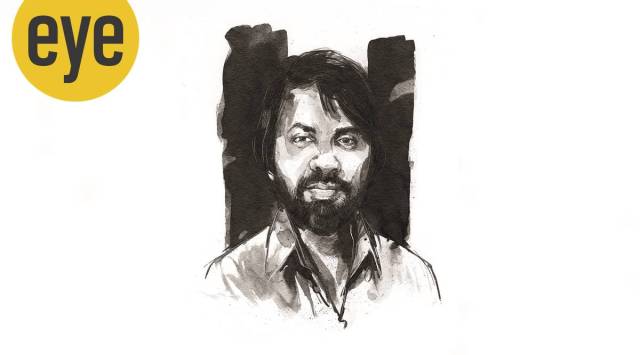 In cold blood: An artist’s impression of Kurup (Illustration: Suvajit Dey)
In cold blood: An artist’s impression of Kurup (Illustration: Suvajit Dey)On a foggy morning, around 4 am on January 22, 1984, a man burst into the Mavelikara police station startling the head constable on duty there. A black Ambassador with the license plate KLQ-7831 was going up in flames in the middle of a paddy field with an almost-charred body of a person in the driving seat, he blurted out. After filing an FIR, officers rushed to the site of the accident where a small crowd had gathered already. There were rumblings that the car might have veered off the road running by the side of the field, catching fire in the process.
Murali Vrindavanam, then a 20-year-old political worker, whose family ran a ration shop in the area, remembered being alerted to the burning car by locals. “The car was such a ball of fire that we couldn’t see anything inside initially. But after some time, when the blaze was put out partially, we realised that there was a person inside who looked as if he was tied to the seat. Some locals who were returning after watching a late-night play recalled seeing a couple of people driving away from the spot in another car,” he said.
It was after the team of then Deputy Superintendent of Police (DySP) PM Haridas reached the spot around 5:30 am and closely inspected the surroundings that tiny clues pointing to the incident being much more than a plain car accident began to stack up. Around the car, officers found a matchbox, a pair of footwear and a rubber glove with a hair in it. The air carried a whiff of petrol and there were footprints in the mud indicating someone fleeing from the spot.
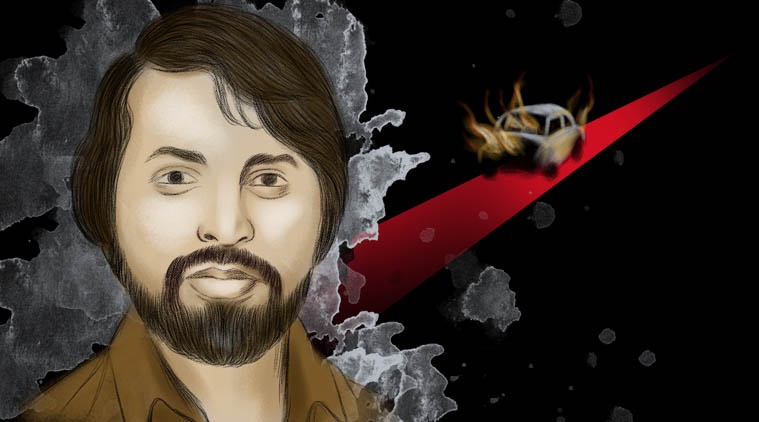 The body in the car was that of Alappuzha-native Chacko, a film representative who became the victim of a diabolical get-rich-quick plot by Kurup, Pillai and two others. (Illustration by By Vishnu Ram)
The body in the car was that of Alappuzha-native Chacko, a film representative who became the victim of a diabolical get-rich-quick plot by Kurup, Pillai and two others. (Illustration by By Vishnu Ram)
The police surgeon was called for and the victim’s body was subjected to post-mortem in the field itself. The examination confirmed the police’s suspicions that the person had been killed before he was placed in the driving seat of the car because there were no traces of charcoal or ash in his respiratory tract. The presence of liquor and ethyl alcohol in the deceased’s digestive tract added to the mystery.
By then, word had spread that the deceased was Sukumara Kurup, a 30-something native of nearby Cheriyanad who had arrived from the Gulf a couple of weeks ago. A few of his relatives arrived at the spot weeping, trying to get a last glimpse of him. Though his face had been charred beyond recognition, his co-brother Bhaskara Pillai testified it was him by the looks of his height, build and the fact that he hadn’t returned home after he drove out to Ambalapuzha, a nearby town, the previous day in that car.

While the remains were handed over to Kurup’s family on the condition that it be buried and not cremated, unknown to the police at the time, Kurup was very much alive and in hiding at a lodge in Aluva, 115 km away. The body found charred in the car, the police later learnt, was that of Alappuzha-native Chacko, a film representative who turned out to be the hapless victim of a diabolical plot hatched by Kurup, Pillai and two others to become rich overnight.
It’s been 36 years since that January morning on which DySP Haridas arrived at the site of a burning car. He had no clue that day that he would be drawn into a murder case that would define his career and go on to become one of the most sensational cases in the criminal history of Kerala. The trial in the case began and ended, the accused have served their time and families, torn apart by the episode, have begun to heal. But one constant remains: Kurup, whose name and exploits got etched in the collective psyche of Malayalis, is still on the run, at least on record.
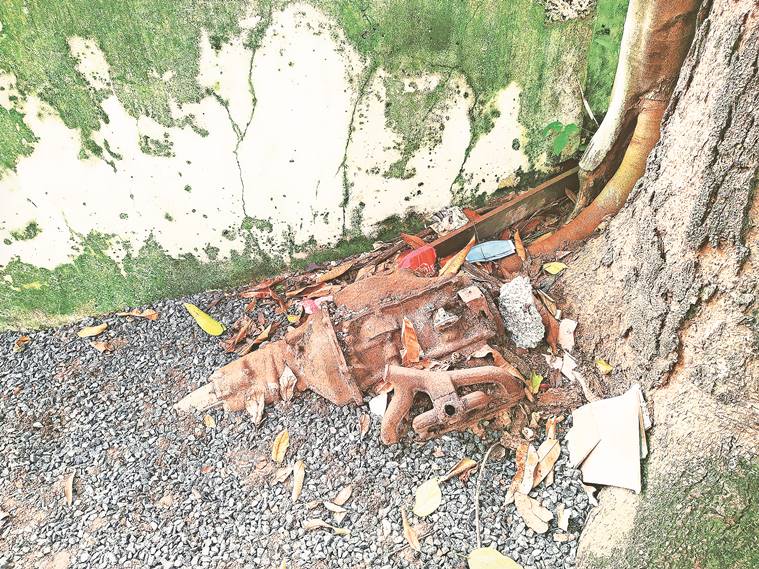 Debris of the engine of the car in which Chacko was burnt still remains at the Mavelikkara police station compound. (Photo credit: Vishnu Varma)
Debris of the engine of the car in which Chacko was burnt still remains at the Mavelikkara police station compound. (Photo credit: Vishnu Varma)
The many faces of Kurup
Sukumara Kurup wasn’t the name he was given at birth. It was Gopalakrishna Kurup.
Born into a middle-class, upper-caste household in Cheriyanad, Kurup was drawn to adventure from an early age. After completing his pre-degree course (the equivalent of today’s Class XII), he joined the Indian Air Force as an airman. But it seemed the work didn’t interest him as he failed to return to his unit after a long leave at home and was thus branded a ‘deserter.’
It was at this juncture that the first shoots of a crooked mind in Kurup began to crop up. By bribing a head-constable in the special branch of the police, he forged a report stating Gopalakrishna Kurup, the ‘airman’, had died and sent it to the IAF to close the ‘deserter’ inquiry. He also bid goodbye to that name when he applied for a passport in order to migrate to the Gulf and took on a new name: Sukumara Pillai. Pillai and Kurup are sub-castes of the Nair community in Kerala.
Kurup displayed the same shades of intrepid behaviour when it came to love. He began a relationship with Sarasamma, whose mother was a domestic help at Kurup’s Cheriyanad home, after he saw her at a relative’s home in Mumbai. Their affair grew as Sarasamma joined for a nursing course in Mumbai when Kurup was in the IAF. When his parents got wind of it, they were furious and sent letters to Sarasamma ordering her to end the affair. But Kurup was insistent. Shortly after he left the IAF and prepared to move to Abu Dhabi, he married Sarasamma in a secret ceremony at a temple in Matunga, rebelling against his family’s wishes.
The next chapter of his life in Abu Dhabi with the Abu Dhabi Marine Operating Company was largely seen as peaceful, according to police accounts. The job brought in a steady income and as an extrovert, Kurup was able to quickly cultivate a band of close friends for whom he was ‘Suku’, the darling of the group. Soon, his wife joined him in Abu Dhabi as a nurse at a private hospital.
According to DySP Haridas, Kurup found happiness in the company of his friends and wasn’t reluctant to spend lavishly on parties. He earned a great deal of goodwill by helping his friends in moments of crisis, irrespective of how close they were to him. One such friend was Shahu, a native of Chavakkad in Thrissur district, who worked as an office boy in Kurup’s firm and went on to play a significant role in the latter’s future. On vacations to Kerala, Kurup brought suitcases filled with goodies for his friends and family as was common in those days with Gulf Malayalis. Throughout his stay, he would insist on picking up the tab on liquor bills for his friends – a sign of superior social and economic status he seemed to take great pride in. During that time, he bought a plot of land at Ambalapuzha to build a house and purchased an Ambassador for leisure trips.
The result of such opulence was a weak bank balance and shoddy financial management. Despite the combined salaries of Kurup and his wife touching Rs 60,000 a month, their savings were depressed. It was around this time that Kurup began to hear strong rumours of companies in the Gulf, including his, planning to shed their existing workforce and hire new workers at lower wages. With his house under construction back home, money was the need of the hour. Kurup’s friends back home were also encouraging him to start a business in Kerala as it would mean no longer being tethered to a fixed salary.
What’s the quickest way to get a lot of money? The answer presented itself to Kurup through a story he accidentally read in an English detective magazine one night. To anyone else, it may have sounded outlandish, but for a man who held a daredevil attitude to life, it seemed just right.
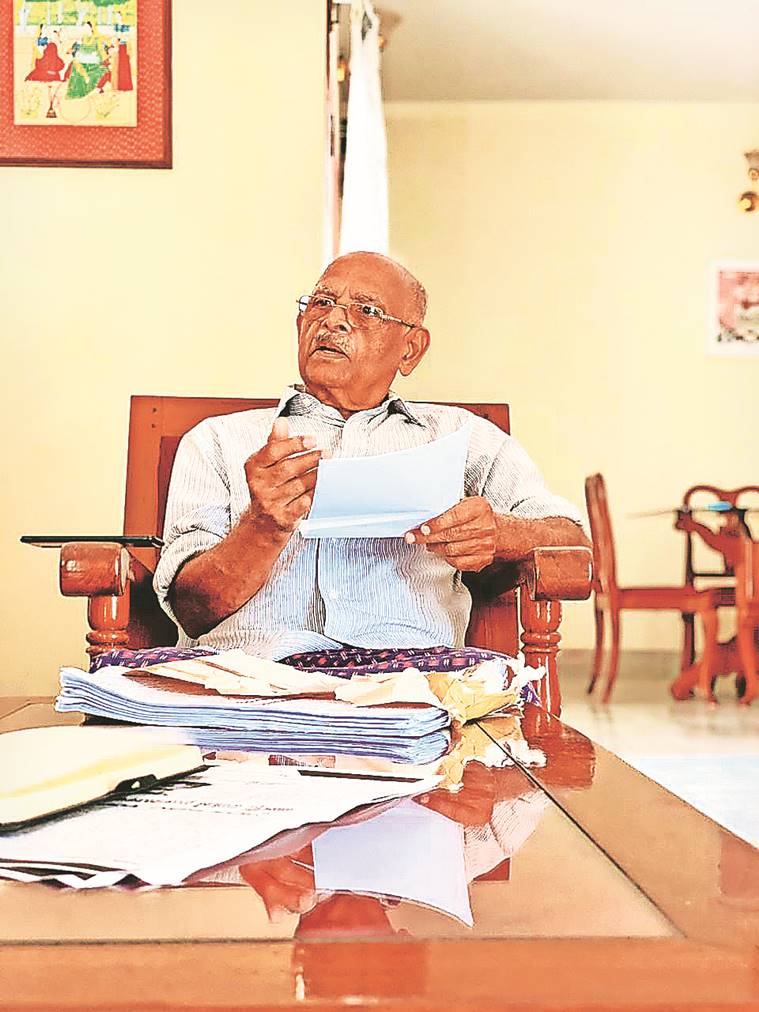 PM Haridas, who was in charge of the probe, at his residence in Kollam (Photo credit: Vysakh Venugopal)
PM Haridas, who was in charge of the probe, at his residence in Kollam (Photo credit: Vysakh Venugopal)
Creating the story
The story was that a man killed another person who held a physical resemblance to him, put him in the driver seat of his car, set fire to it to make it appear as an accident and then claimed insurance for his life.
The more Kurup thought about it, the more it seemed plausible. But he needed help. One night in Abu Dhabi, he presented the idea to Shahu after a round of drinks just to gauge his response. All they had to do was make it seem like an accident, convince the police and locals that Kurup died, claim insurance and split the money. Once Shahu, who had financial problems of his own including marrying off three sisters at home, nodded to the plan, Kurup roped in Pillai and his driver Ponnappan as well. From then on, things moved quickly.
Pillai bought a second-hand Ambassador for Rs 8,000 and Kurup and Shahu, having taken leave from the company, arrived at the Thiruvananthapuram international airport in the first week of January.
“Kurup’s initial idea was to get an unclaimed dead body for the operation. Pillai had a relative who worked at the Alappuzha Medical College and he felt it wouldn’t be difficult to source a dead body. Or else a body could be scavenged from a cemetery,” said DySP Haridas.
“But when Pillai told him that sourcing a dead body was impossible, Kurup casually suggested murder. And just like that, everyone got onboard” he added.
 The erstwhile paddy field where the burning car was found
The erstwhile paddy field where the burning car was found
On the intervening night of January 21-22, 1984, Kurup, Pillai, Shahu and Ponnappan assembled at the Kalpakavadi Hotel at Karuvatta on the National Highway 47 for dinner before they went hunting for a victim, multiple police accounts said. After dinner and generous helpings of liquor, the four of them trooped into two cars – Kurup in the newly-purchased KLQ-7831 and the others in a car with the license plate KLY-5959.
The four of them in two cars, one behind the other, rode through the highway at night up till Oachira, a distance of about 25 km, without finding any luck. Turning back, as they approached the Hari movie theatre near Haripad, they saw a man by the side of the road stretching his hand for a lift. “Are you going towards Alappuzha?” the stranger asked. “Come on in,” said Ponnappan, as he exchanged looks with Pillai and Shahu.
The man identified himself as Chacko, a film representative who was returning home after assessing the ticket collections at the theatre. As the car proceeded toward Alappuzha, Pillai struck the first move by offering Chacko a glass of brandy laced with ether. But the latter declined. Pillai offered him a second time, this time in a sterner tone. When Chacko said no yet again, it was a sign for Ponnappan to swerve out of the highway into a side road. “Drink it,” Pillai shouted menacingly at Chacko and this time, the latter, out of fear, gulped it down in one swig and fell unconscious in a matter of seconds.
Together, Pillai and Shahu, using a towel they carried, strangled Chacko to death, the chargesheet said. The four of them then headed to ‘Smita Bhavan’, Kurup’s wife’s native place where they scorched Chacko’s face and head to make him indistinguishable. They removed his clothes, ring and watch and dressed him in Kurup’s clothes. Putting his body in the boot of KLY-5959, the group, in two cars, proceeded toward the paddy field at Thannimukkam.
There, in the final act of their depraved conspiracy, the group placed Chacko in the driving seat of KL-Q-7831 ambassador, pushed it toward the paddy field, poured petrol over it and lit it on fire.
 The post-mortem confirmed the police’s suspicions — the person had been killed before being placed in the driver’s seat (Illustration by By Vishnu Ram)
The post-mortem confirmed the police’s suspicions — the person had been killed before being placed in the driver’s seat (Illustration by By Vishnu Ram)
The probe
Behind the Mavelikara police station today, a portion of the radiator of the burnt Ambassador from that January morning of 1984 still lies enmeshed with the soil at the bottom of a tree. It is the last remaining physical remnant of a brutal criminal episode.
The Thannimukkam paadam, or field, has been overrun by wild bushes and weeds over time, though it has taken on a new name after 1984 – ‘Chacko paadam’. As cars and buses swing by the field, even today, drivers often slow down and phone cameras rise up instinctively to capture a place of infamous proportions.
The 81-year-old Haridas, long-retired as Superintendent of Police and now at his residence in Kollam, has occasional memory lapses. But there are certain things he still remembers vividly from that time. Like, for example, how he picked up on small observations during the initial days of the investigation to conclude that Kurup wasn’t the one who died in the car.
“Even at the time of Kurup’s supposed death, I could gauge that there wasn’t real grief in his house. No one appeared sad that the most important member of the family had passed away. What’s more, they had even prepared chicken curry for lunch the day of the accident. In those days, chicken was reserved only for special occasions and certainly not cooked when there’s been a death in the family,” recalled Haridas.
Another strong indicator was the suspicious burn marks on Pillai’s forehead and hand, incurred accidentally when he had set the car on fire. But when questioned by the police, Pillai first said he got burnt while lighting a fire to keep the cold away. The story changed in a matter of minutes: he got burnt while carrying hot water in a vessel. When his testimonies began getting contradictory, the police knew there were more people in the loop.
It was then-Mavelikkara circle inspector KJ Devasia, now retired from the force, who apprehended Shahu from his home in Chavakkad and questioned him on the mystery man who was set on fire. “It was around midnight when I, along with a colleague, reached Chavakkad. It was a coastal area. When I knocked at Shahu’s home, he was just getting ready to leave his home and catch a bus to Kochi from where he planned to escape to the Gulf. Had I reached an hour late, I would have missed him. I threw him into the jeep and quickly rode out of the area before locals could intercede,” said the retired officer on the phone.
Upon questioning, it didn’t take long for Shahu to spill the details of the conspiracy, making his testimony the bedrock of the police case. To find out the identity of the deceased, the police sent out messages to all nearby police stations for missing person complaints. Promptly, in Alappuzha, a complaint filed by Chacko’s brother stood out and based on his physical resemblance to Kurup, the police was able to confirm that it was Chacko who was killed.
Devasia added, “At that time, I was all of 30 and newly-married. I didn’t have a major role to play in the case, but once I had locked in Shahu, I felt as if I had done my part. I was very happy to contribute to the case.”
With Kurup untraceable, the police filed a chargesheet arraigning Pillai and Ponnappan as the first and second accused in the case on charges of murder, conspiracy and destruction of evidence among others. Shahu, initially charged as one of the accused, was made a police approver. Pillai and Ponnappan were found guilty by the sessions court and sentenced to life in prison. The wives of Kurup and Pillai, arraigned as third and fourth accused in the case, were acquitted for lack of evidence.
Where luck aided the police in catching Shahu and solving the case, it eluded them on multiple occasions when it came to Kurup. Police accounts said Kurup had travelled to Mavelikara and his native Cheriyanad at least two times after Chacko’s murder to meet his family and gather money to sustain himself on the run. The closest the police came to trapping Kurup was in Aluva where the latter was holed up in a lodge for a few days.
Then Kayamkulam-circle inspector Jayaprakash, now retired as Superintendent of Police, recalled the time when he was deputed to Aluva that night. “Very late into the night, we got a lead from one of Kurup’s relatives that he was in a lodge near the railway station in Aluva. I immediately set off from Mavelikara just after midnight and reached Aluva around 3-4 am. But when we reached the lodge, we realised that he had left Aluva by the Malabar Express a few hours ago. When we showed his photograph, the receptionist confirmed he was there,” he said.
 Chacko’s wife in front of his photo
Chacko’s wife in front of his photo
“If we had gotten the information a few hours earlier, we would have caught him. It’s just about timing,” he said.
Over the next decade, the hunt for Kurup by the Kerala Police became something of a prestige issue, transcending beyond the state to north Indian cities like Gwalior, Bhopal and Itarsi, to the Andaman & Nicobar Islands, to Bhutan and the Gulf countries. Such was the mad-like fixation with catching him that officers like him, Jayaprakash said, even borrowed and spent money from their own pockets to travel in search of solid leads. It agonised them to no end that he could elude them. As Kurup’s personable, bearded photograph was publicised widely during that time, the police control room was flooded with calls claiming to have spotted him.
Haridas’s wife said of her husband, “He would have a packed bag ready all the time. When the call comes, he would rush off. I have worried for him so many times.”
In 1984 itself, the murder case found reflection in the film ‘NH-47’ in which TG Ravi played Kurup. More recently, actor Dulquer Salmaan is slated to play the character in a forthcoming movie titled Kurup. The movie has been slammed already by a legal notice filed by late Chacko’s son complaining that his father’s killer should not be glorified as a hero.
Devasia remarked, “I believe if Kurup was caught back then, the case wouldn’t have generated so much publicity or become memorable in the minds of the people. But since he’s never been caught, hence the enigma and interest.”
At a hospital in Ranchi once, a Malayali nurse who claimed to have treated Kurup during his run, told police officers that he’s not likely to live long as he suffered from a serious illness. If he is alive today, he would be 74 years old.
For now, his name continues to figure in the ‘long pending’ list of criminal cases in Kerala.
With inputs by Deborah Thambi
















